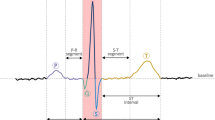Abstract
Electrocardiogram (ECG) signal denoising is an important preprocessing for ECG signal analysis. The contaminated ECG signal can be considered as the combination of the desired clean signal and the noise. Thus, ECG signal denoising can be considered as a problem of obtaining an optimal solution to the desired clean signal. In this paper, an effective optimization scheme for ECG signal denoising is presented based on low-rank matrix decomposition. First, the ECG denoising problem is formulated as low-rank matrix decomposition. So, an ECG beats matrix is assumed to be the combination of a sparse noise matrix and a low-rank matrix. Considering the repeatability of ECG signal, the rank of the ECG beats matrix is assumed to be one. Then, to fully exploit the low-rank property of the ECG signal, the matrix decomposition is modified by means of adding different weights to different singular values. Finally, the desired clean ECG signal is reconstructed by the low-rank component. The experimental results show that the proposed denoising method achieves the best performance of suppressing the electromyographic noise in the ECG signals compared with other optimization models.




Similar content being viewed by others
References
H. Abdi, L.J. Williams, Principal component analysis. Wiley Interdiscip. Rev. Comput. Stat. 2(4), 433–459 (2010)
M. Alfaouri, K. Daqrouq, ECG signal denoising by wavelet transform thresholding. Am. J. Appl. Sci. 5(3), 276–281 (2008)
M. Ayat, M.B. Shamsollahi, B. Mozaffari, S. Kharabian, ECG denoising using modulus maxima of wavelet transform, in Engineering in Medicine and Biology Society (2009), pp. 416–419
M. Blanco-Velasco, B. Weng, K.E. Barner, ECG signal denoising and baseline wander correction based on the empirical mode decomposition. Comput. Biol. Med. 38(1), 1–13 (2008)
J.F. Cai, E.J. Candès, Z. Shen, A singular value thresholding algorithm for matrix completion. SIAM J. Optim. 20(4), 1956–1982 (2010)
E.J. Candès, X. Li, Y. Ma, J. Wright, Robust principal component analysis? J. ACM (JACM) 58(3), 11 (2011)
M. Dai, S.L. Lian, Removal of baseline wander from dynamic electrocardiogram signals, in Image and Signal Processing (2009), pp. 1–4
O. El B’charri, R. Latif, K. Elmansouri, A. Abenaou, W. Jenkal, ECG signal performance de-noising assessment based on threshold tuning of dual-tree wavelet transform. Biomed. Eng. Online 16(1), 26 (2017)
S. Gu, L. Zhang, W. Zuo, X. Feng, Weighted nuclear norm minimization with application to image denoising, in Proceedings of the IEEE Conference on Computer Vision and Pattern Recognition (2014), pp. 2862–2869
S. Gu, Q. Xie, D. Meng, W. Zuo, X. Feng, L. Zhang, Weighted nuclear norm minimization and its applications to low level vision. Int. J. Comput. Vis. 121(2), 183–208 (2017)
V. Gupta, V. Chaurasia, M. Shandilya, Random-valued impulse noise removal using adaptive dual threshold median filter. J. Vis. Commun. Image Represent. 26, 296–304 (2015)
P.S. Hamilton, W.J. Tompkins, Quantitative investigation of QRS detection rules using the MIT/BIH arrhythmia database. IEEE Trans. Biomed. Eng. 12, 1157–1165 (1986)
G. Han, B. Lin, Z. Xu, Electrocardiogram signal denoising based on empirical mode decomposition technique: an overview. J. Instrum. 12(03), P03010 (2017)
W. Huang, N. Cai, W. Xie, Q. Ye, Z. Yang, ECG baseline wander correction based on ensemble empirical mode decomposition with complementary adaptive noise. J. Med. Imaging Health Inform. 5(8), 1796–1799 (2015)
W. Jenkal, R. Latif, A. Toumanari, A. Dliou, O. El B’charri, F.M. Maoulainine, An efficient algorithm of ECG signal denoising using the adaptive dual threshold filter and the discrete wavelet transform. Biocybern. Biomed. Eng. 36(3), 499–508 (2016)
M. Kotas, Projective filtering of time-aligned ECG beats. IEEE Trans. Biomed. Eng. 51(7), 1129–1139 (2004)
M. Kotas, Application of projection pursuit based robust principal component analysis to ECG enhancement. Biomed. Signal Process. Control 1(4), 289–298 (2006)
M. Kotas, Projective filtering of time warped ECG beats. Comput. Biol. Med. 38(1), 127–137 (2008)
Z. Lin, M. Chen, Y. Ma, The augmented Lagrange multiplier method for exact recovery of corrupted low-rank matrices. arXiv preprint arXiv:1009.5055 (2010)
A.J. Nimunkar, W.J. Tompkins, EMD-based 60-Hz noise filtering of the ECG, in Engineering in Medicine and Biology Society (2007), pp. 1904–1907
L. Sornmo, Time-varying filtering for removal of baseline wander in exercise ECGs, in Computers in Cardiology (1991), pp. 145–148
The MIT-BIH arrhythmias database. http://physionet.org/physiobank/database/mitdb/. Accessed 26 Oct 2016
The MIT-BIH arrhythmias database. http://physionet.org/physiobank/database/nstdb/. Accessed 26 Oct 2016
J.A. Van Alste, T.S. Schilder, Removal of base-line wander and power-line interference from the ECG by an efficient FIR filter with a reduced number of taps. IEEE Trans. Biomed. Eng. 12, 1052–1060 (1985)
J.A. Van Alste, W. Van Eck, O.E. Herrmann, ECG baseline wander reduction using linear phase filters. Comput. Biomed. Res. 19(5), 417–427 (1986)
R. Warlar, C. Eswaran, Integer coefficient bandpass filter for the simultaneous removal of baseline wander, 50 and 100 Hz interference from the ECG. Med. Biol. Eng. Comput. 29(3), 333–336 (1991)
J. Wright, A. Ganesh, S. Rao, Y. Peng, Y. Ma, Robust principal component analysis: Exact recovery of corrupted low-rank matrices via convex optimization, in Advances in neural information processing systems, (Vancouver, B.C., Canada, 2009), pp. 2080–2088
Y. Zhou, X. Hu, Z. Tang, A.C. Ahn, Sparse representation-based ECG signal enhancement and QRS detection. Physiol. Meas. 37(12), 2093 (2016)
Acknowledgements
This work was supported in part by the National Natural Science Foundation of China (Grant Nos. 61001179 and 61571139), Guangdong Science and Technology Plan (Grant Nos. 2015B010104006, 2015B010124001 and 2015B090903017) and Guangzhou Science and Technology Plan (Grant Nos. 201604016022, 201803010065 and 201802020007).
Author information
Authors and Affiliations
Corresponding author
Rights and permissions
About this article
Cite this article
Ye, Q., Cai, N., Xia, H. et al. An Effective Optimization Scheme for ECG Signal Denoising via Low-Rank Matrix Decomposition. Circuits Syst Signal Process 38, 138–152 (2019). https://doi.org/10.1007/s00034-018-0845-1
Received:
Revised:
Accepted:
Published:
Issue Date:
DOI: https://doi.org/10.1007/s00034-018-0845-1




